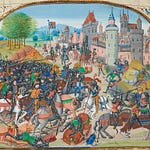Originally published on August 8, 2022 (Episode 275)
Introduction
The pandemic of 1346—the Black Death—killed as much as half the population in some parts of Europe. Yet the catastrophe did not end there: for the next three centuries, at least thirty further outbreaks followed. The result was unimaginable suffering and tragedy from which no one was untouched.
But the Black Death also set in motion cultural and economic renewal. Labor scarcity encouraged new or improved technologies—wind power, water power, gunpowder. Rising disposable incomes expanded consumption of silks, sugars, spices, furs, gold, and slaves. It was not despite the plague, argues James Belich, but because of it, that Europe flourished.
About the Guest
James Belich is the Beit Professor of Imperial and Commonwealth History at the University of Oxford and cofounder of the Oxford Centre for Global History. His books include a two-volume history of New Zealand, Making Peoples and Paradise Reforged. His most recent book is The World the Plague Made: The Black Death and the Rise of Europe (Princeton University Press, 2022).
For Further Investigation
James Belich, The World the Plague Made: The Black Death and the Rise of Europe (Princeton University Press, 2022)
James Belich, Making Peoples: A History of the New Zealanders from Polynesian Settlement to the End of the Nineteenth Century (University of Hawaii Press, 2002)
James Belich, Paradise Reforged: A History of the New Zealanders, 1880–2000 (Allen Lane, 2001)
James Belich, Replenishing the Earth: The Settler Revolution and the Rise of the Angloworld (Oxford University Press, 2009)
Related conversations:
💬 Listen & Discuss
Was Europe’s “rise” in the wake of the plague a tragedy turned opportunity? Share your thoughts in the comments, and pass this episode along to someone interested in the deep history of pandemics.











